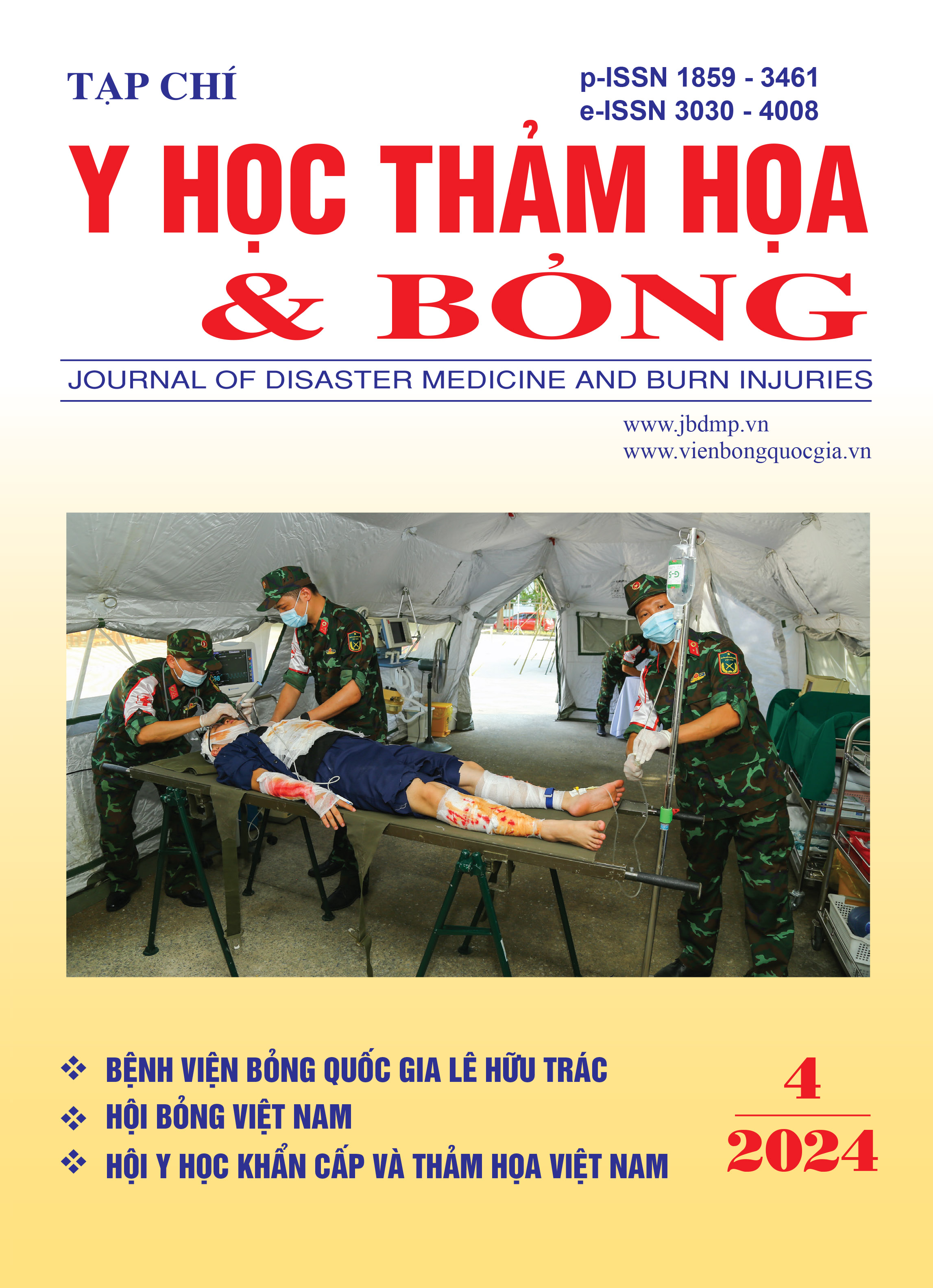Comparation the quality of recovery after Propofol anesthesia versus Sevoflurane anesthesia for cosmetic surgery
Main Article Content
Abstract
Objective: Compare the quality of recovery between two groups of patients anesthetized with Propofol or Sevoflurane for cosmetic surgery.
Methods: Prospective, clinical intervention, randomized comparison study on 60 patients divided into 2 groups P (n=30) anesthetized with Propofol and group S (n = 30) anesthetized with Sevoflurane. Evaluate the time points of the recovery phase, adverse events after surgery, compare the quality of recovery using the QoR-40 scale.
Results: Time to regain consciousness, time to full consciousness, time to extubation or laryngeal mask, rate of vomiting, nausea in customers in group P was lower than in group S (p < 0.05); the quality of recovery score according to QoR-40 in group P was statistically higher than in group S (p < 0.05).
Conclusion: Recovery quality after Propofol anesthesia for cosmetic surgery is better than that after Sevoflurane anesthesia.
Article Details
Keywords
Quality of recovery, propofol, sevoflurane, cosmetic surgery
References
2. Kumar G, Stendall C, Mistry R, Gurusamy K, Walker D. A comparison of total intravenous anesthesia using propofol with sevoflurane or desflurane in ambulatory surgery: systematic review and meta-analysis. Anesthesia. 2014; 69(10):1138-50.
3. Hofer CK, Zollinger A, Buchi S, Klaghofer R, Serafino D, Buhlmann S, et al. Patient well-being after general anesthesia: a prospective, randomized, controlled multi-centre trial comparing intravenous and inhalation anesthesia. Br J Anaesth. 2003;91(5):631-7.
4. Fassoulaki A, Melemeni A, Paraskeva A, Siafaka I, Sarantopoulos C. Postoperative pain and analgesic requirements after anesthesia with sevoflurane, desflurane or propofol. Anesth Analg. 2008;107(5):1715-9.
5. Li M, Mei W, Wang P, Yu Y, Qian W, Zhang ZG, et al. Propofol reduces early post-operative pain after gynecological laparoscopy. Acta Anaesthesiol Scand. 2012;56(3):368-75.
6. Fredman B, Nathanson MH, Smith I, Wang J, Klein K, White P. Sevoflurane for outpatient anesthesia: a comparison with Propofol. Anesth Analg. 1995; 81(4):823-8.
7. Brioni JD, Varughese S, Ahmed R, Bein B. A clinical review of inhalation anesthesia with sevoflurane: from early research to emerging topics. J Anesth. 2017;31(5):764-78.
8. Nguyễn Thị Diệu Linh, Hoàng Văn Bách, Công Quyết Thắng. So sánh hiệu quả gây mê theo nồng độ đích của Et Control- Sevoflurane với TCI - Propofol dưới chỉ dẫn của điện não hóa số. Tạp chí Y học Việt Nam. 530, 1B (tháng 9 2023). DOI:https://doi.org/10.51298/vmj.v530i1B.6716.
9. Myles PS, Weitkamp B, Jones K, et al. Validity and reliability of a postoperative quality of recovery score: the QoR-40. British Journal of Anaesthesia 84 (1): 11–15 (2000).
10. Hofer CK, Zollinger A, Buchi S, Klaghofer R, Serafino D, Buhlmann S, et al. Patient well-being after general anesthesia: a prospective, randomized, controlled multi-centre trial comparing intravenous and inhalation anesthesia. Br J Anaesth. 2003;91(5):631-7.
11. Vasileiou I, Xanthos T, Koudouna E, Perrea D, Klonaris C, Katsargyris A, et al. Propofol: a review of its non-anaesthetic effects. Eur J Pharmacol. 2009; 605(1-3):1-8.
12. Li KY, Xiao C, Xiong M, Delphin E, Ye JH. Nanomolar propofol stimulates glutamate transmission to dopamine neurons: a possible mechanism of abuse potential? J Pharmacol Exp Ther. 2008;325(1):165–74.
13. Yoo YC, Bai SJ, Lee KY, Shin S, Choi EK, Lee JW. Total intravenous anesthesia with propofol reduces postoperative nausea and vomiting in patients undergoing robot-assisted laparoscopic radical prostatectomy: a prospective randomized trial. Yonsei Med J. 2012; 53(6):1197-202.
14. Barann M, Göthert M, Fink K, Bönisch H. Inhibition by anaesthetics of 14 Cguanidinium flux through the voltage-gated sodium channel and the cation channel of the 5-HT 3 receptor of N1E-115 neuroblastoma cells. Naunyn Schmiedeberg's Arch Pharmacol. 1993;347(2):125-32.
15. Gilliland HE, Armstrong MA, Carabine U, McMurray TJ. The choice of anesthetic maintenance technique influences the antiinflammatory cytokine response to abdominal surgery. Anesth Analg. 1997;85(6):1394-8.
16. Crippa J, Mari GM, Miranda A, Costanzi AT, Maggioni D. Surgical stress response and enhanced recovery after laparoscopic surgery - a systematic review. Chirurgia (Bucur). 2018;113(4):455-63.
17. Ledowski T, Paech MJ, Patel B, Schug SA. Bronchial mucus transport velocity in patients receiving propofol and remifentanil versus sevoflurane and remifentanil anesthesia. Anesth Analg. 2006;102(5):1427-30.


